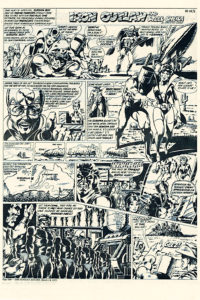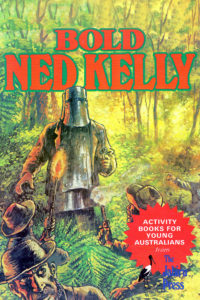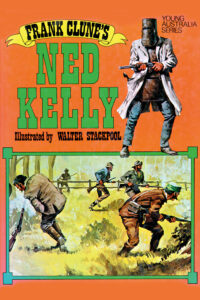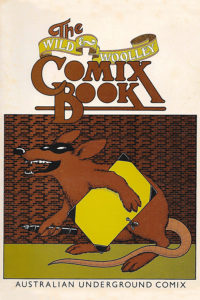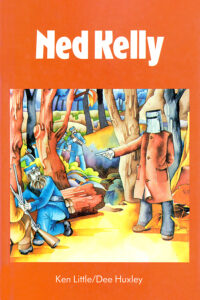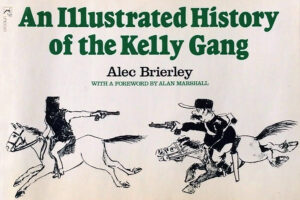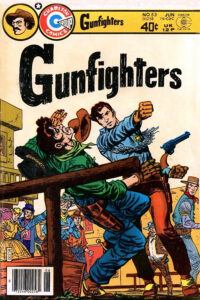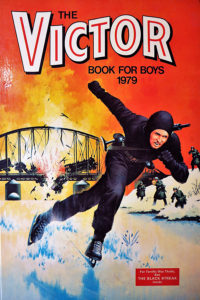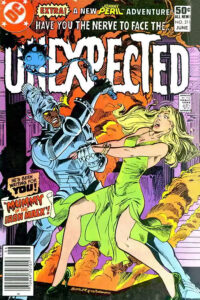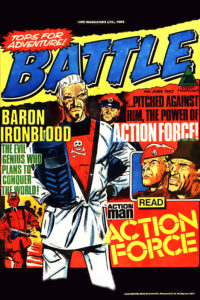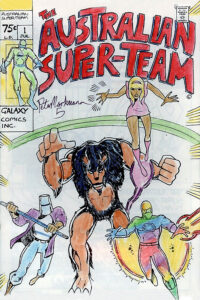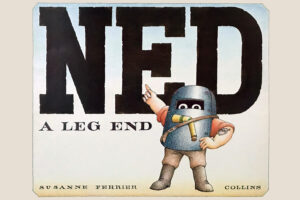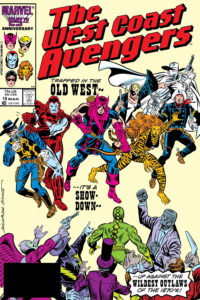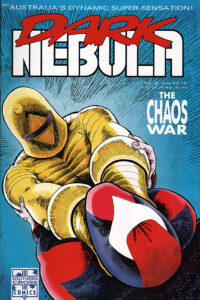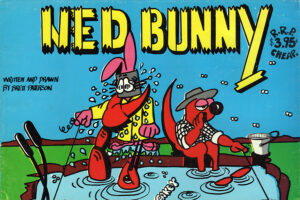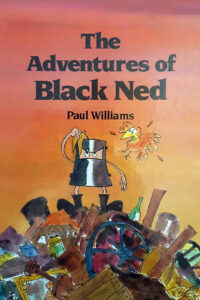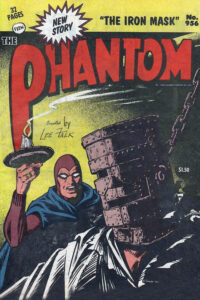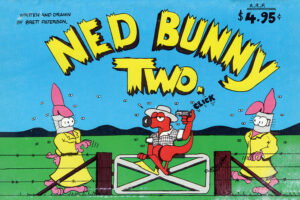ILLUSTRATIVE TEXT
20th CENTURY
… Iron Man stood in front of the hotel and looked across the main street. He saw the desperadoes peer from their hiding places, and turn their rifle muzzles to face him. Black Jack was crouching behind a rain-barrel. Slowly and deliberately, Iron Man walked towards Black Jack. Immediately, Black Jack and his gang opened fire. Bullets ricocheted off Iron Man’s helmet and chest plate. Iron Man walked on. Black Jack emptied his magazine and fitted another clip of ammunition into his rifle. Still Iron Man walked on. “It’s a ghost!” yelled one of the desperadoes. “…the Ghost of Ned Kelly.” Immediately the gang, including Black Jack, turned and fled, using any horse, carts or trucks they could find.
The Ghost of Ned Kelly from Marvel Story Book Annual
This section examines 20th century illustrated news, story papers and books, nickel and dime novels, comic books and strips, and graphic novels whose notions explore aspects of Ned Kelly folklore. From his rebellious spirit and defiance of authority to the iconic imagery of his armour, Ned’s narrative has permeated our artistic awareness and influenced popular culture at a conscious and subconscious level. This impact can be seen in mid-century American Western comics and boys’ weeklies from the United Kingdom. These representations would affect the origin stories of several modern-day superheroes [and villains] manifesting themselves through diverse reincarnations and reinterpretations.
- 1905
The Buffalo Bill Stories
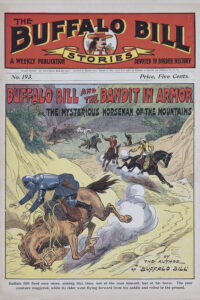 Issue: #193
Issue: #193
Publisher: Street & Smith
Date: 21 January 1905
Format: Nickle & Dime
Extent: 30 pagesStory: Buffalo Bill and the Bandit in Armor
Based in New York, Street & Smith published The Buffalo Bill Stories, a ‘nickel & dime’ weekly, from May 18, 1901 to September 7, 1912. The publisher described the series as: ‘Original tales of Buffalo Bill’s adventures…the only publication authorized by the Hon. Wm. F. Cody (Buffalo Bill). We were the publishers of the first story ever written of the world-renowned Buffalo Bill, the great hero whose life has been one succession of exciting and thrilling incidents continued with great successes and accomplishments, all of which will be told in a series of grand stories which we shall now place before the American boys.’
The bullets could not penetrate that steel armor, and, with another wild laugh, the horseman disappeared round a bend of the crooked trail, bearing his captive.
Link: DimeNovels.lib.niu.edu
- 1934
The Triumph
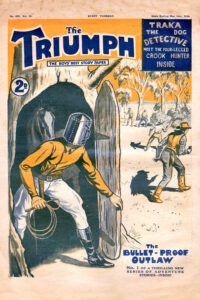 Issue: #499 to #508
Issue: #499 to #508
Publisher: The Amalgamated Press
Editor: Reg Eves
Format: Story Paper
Extent: 24 pagesStory: The Bullet-Proof Outlaw
Script: Hal WiltonThe Triumph was a British Story Paper for boys. It was published weekly by The Amalgamated Press based at Fleetway House in Farringdon Street, London. Following the demise of The Rocket, it ran from October 1924 to May 1940 for a total of 814 issues. During its long run, it incorporated The Boy’s Friend in January 1928, then The Gem in January 1940 for a short spell before being merged with The Champion in May of the same year. Billed in some of its issues as ‘Every Yarn’s A Thriller’, it featured a broad spectrum of thrilling adventure stories. One such story was The Bullet-Proof Outlaw. The ten-part episodic narrative by Hal Wilton featured the Australian outlaw Iron Mask and ran consecutively through issues 499 to 508.
Read: The Bullet-Proof Outlaw #499
Read: The Bullet-Proof Outlaw #505
Read: The Bullet-Proof Outlaw #506
Read: The Bullet-Proof Outlaw #507 - 1938
Bushrangers
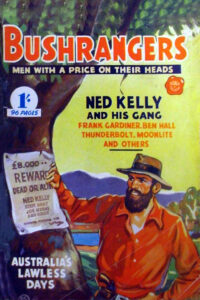 Men with a price on their heads
Men with a price on their headsIssue: #1
Creator: William Henry Fitchett
Publisher: Fitchett Brothers Pty Ltd
Published: 1938
Format: Story Paper
Extent: 96 pagesStory: Ned Kelly and His Gang
Script: W.H. Fitchett‘The true story of the exploits of Australia’s most famous gang of bushrangers told by a notable historian’.
One of the Strangest Stories in the History of Crime Under Any Sky.
- 1941
Zip Comics
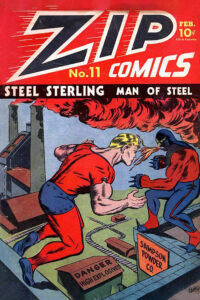 Issue: #11
Issue: #11
Publisher: M. L. J. Magazines Inc.
Date: February 1941
Format: Comic Book
Extent: 68 pagesStory: Enter: The Rattler [14 pages]
Creators: Biro & BlairTwisto has developed a new bulletproof outfit that looks like a scaled serpent, and he now calls himself The Rattler. Steel is also in disguise to catch the criminals. Inferno saves the life of Steel when the Rattler tries to kill him with his poison needles.
After being thwarted in a bank robbery, Twisto [The Rattler] dons an armoured chest plate and a rattlesnake costume and then seeks revenge against his accomplice, Inferno [The Fire Breather], and his nemesis, Steel Sterling [John Sterling].
View: Enter: The Rattler [page 9]
- 1941
Police Comics
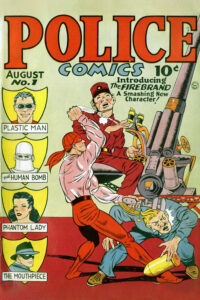 Issue: #1
Issue: #1
Publisher: Comic Magazines Inc.
General Manager: E.M. Arnold
Editor: Edward Cronin
Date: August 1941
Format: Comic Book
Extent: 68 pagesStory: The Origin of the Human Bomb [6 pages]
Script: Paul Gustavson
Illustrator: Paul CarrollAn Axis consul makes several attempts to steal a new explosive capsule invented by the late Professor Lincoln. He ultimately receives its power, but not in the manner he expected. Story characters included The Human Bomb [Roy Lincoln], Professor Lincoln [Roy’s father, death], Fritz [villain, death], Baldy [villain], Riker [villain], and the unnamed Axis consul [villain, death]. A black and white restoration [or homage ] to this story by Jack Cole was printed in the 1996 edition of Golden-Age Men of Mystery #12.
The Human Bomb [aka Roy Lincoln] wears a bulletproof [and bombproof] costume that protects him from gunfire and bystanders from his explosive powers. The suit features a Kelly Gang-style helmet complete with a slitted visor. When Roy Lincoln wishes to detonate an antagonist, he removes a glove and touches the person – boom!
- 1942
Spy Smasher
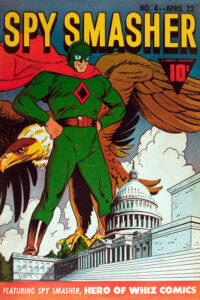 Issue: #4
Issue: #4
Creator: C. C. Beck and Bill Parker
Publisher: Fawcett
Date: 22 April 1942
Format: Comic Book
Extent: 68 pagesStory: The Man in the Iron Mask [13 pages]
Script: Bill SchellySimilar to Batman and the Blue Beetle, Spy Smasher [secretly the ‘wealthy Virginia sportsman’ Alan Armstrong] is a master detective, equipped with a number of gadgets and a specialised vehicle, the ‘Gyrosub’, which was a combination of aeroplane, automobile, and submarine. Spy Smasher was introduced in Whiz Comics #2 [February 1940]. Alongside Captain Marvel, Spy Smasher became one of the magazine’s most popular characters. His perpetual enemy was the Mask, the mastermind of a deadly spy ring.
In this issue, Admiral Corby takes Alan and Eve out to see the reconstruction of Castle Fenmore into an American fort and is saved from death by Alan. Soon, the trio hear weird music and the admiral relates facts about a mysterious ‘Man in the Iron Mask’, rumoured to be a foreign agent wanting to sabotage American defences. Spotting the villain, Alan changes to Spy Smasher and confronts the man, who escapes, then begins killing off the construction workers.
Read: The Man in the Iron Mask
- 1942
America's Best Comics
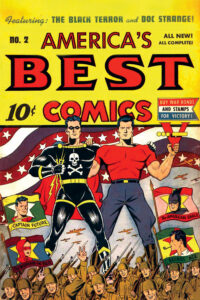 Issue: #2
Issue: #2
Publisher: Pines Publishing
Editor: Ned Pines
Date: 1 September 1942
Format: Comic Book
Extent: 68 pagesStory: The Red Regent [9 pages]
Artist: Kin PlattPublished from February 1942 to July 1949, America’s Best Comics ran for thirty-one issues [numbered 1-31]. In this issue, Captain Future [Dr. Andrew Bryant] faces up against The Red Regent, a rogue Nazi agent fitted with a power suit and imbued with the ability to control and manipulate fire.
The Red Regent was once an average German labourer. One day, he was knocked into a blast furnace while wearing an asbestos suit. He was pulled out of the fire in seconds, but the suit fused to his body, sealing in 1700 degrees of heat. He amazingly survived gaining superpowers. Red Regent tricked Hitler into believing he would serve him, but he was serving his own interests. In his first and only encounter with Captain Future, Future would cause Regent’s car to crash. This did not kill him but only made him angry. Despite a promise to return, he is never seen again.
In October 2021, Thrilling Nostalgia Comics, an indie comic book publisher specialising in using public domain heroes of the 1940s for all-new adventures, reproduced The Red Regent story in The Liberty Brigade: The Heroes Files, a 136-page Golden Age graphic novel, using artists and inkers from Marvel, DC, and other companies.
Read: The Red Regent
View: The Liberty Brigade [cover] - 1945
The Kelly Gang Rides
 Issue: #1
Issue: #1
Creator: Lucky Doolan
Publisher: L. Clapperton
Format: Comic Book
Extent: 48 pagesCover: The Kelly Gang Rides
Artist: Lucky Doolan
Story: The Kelly Gang Rides [32 pages]
Script: Lucky Doolan
Pencil: Lucky DoolanThe Kelly Gang Rides was a comic book aimed at the adolescent market which presented a westernised version of Ned Kelly. The story depicted the Gang dressed in ‘modern’ 1940s clothing and Ned with a moustache [which was the look of the day] as opposed to a full beard. Subsequent artists would use this ‘follicly challenged’ likeness in creating their own interpretations of Ned in Gangsters Can’t Win #1 and The Westerner Comics #25.
‘The Kelly Gang Rides’ – a rather strange digest-sized comic published around 1945 – featured an accurate retelling of the life of Ned Kelly.
Bonzer Australian comics 1900s – 1990s
Read: The Kelly Gang Rides
- 1946
Kaark the Crow
Creator: Kenneth Neville
Publisher: John Fairfax and Sons Pty Ltd
Publication: The Sydney Morning Herald
Format: Comic StripStory: Kaark the Crow: Bushranger
Script: Kenneth Neville
Artist: Anne DrewThe Bushranger story arc ran in the weekly Wednesday section of Playtime Children’s Newspaper inside The Sydney Morning Herald from November 1946 to March 1947. It featured a crow named Kaark and an owl named Red Jelly. The cheeky themes were similar to Dorothy Wall’s Blinky Bill. Kaark also enjoyed dressing as a woman to rob unsuspecting characters. Could it be possible Peter Carey got his fascination with transvestism in a True History of the Kelly Gang from reading this comic strip?
‘Kaark the Crow’ was written by Kenneth Neville and drawn by Anne Drew. While strips about animals and birds were not new, Neville’s innovation was that he made the leading character something of a scoundrel. Kaark tried to take over the valley with the idea of charging the other bush creatures rent and even turned to bushranging for a period. His accomplice in the latter endeavour was Red Jelly who wore a large jam tin over his head and, once again, reflected our writers’ and artists’ fascination with the Ned Kelly mythology.
John Ryan Panel by Panel
View: Kaark the Crow: Bushranger [sample]
- 1947
Stockwhip Sam
Creator: J.A. ‘Bart’ Barlock
Publisher: John Fairfax and Sons Pty Ltd
Publication: The Sydney Morning Herald
Format: Comic StripStory: The Bunyip of Bumble Lake
Script: J.A. Barlock
Artist: J.A. BarlockThe Bunyip story arc ran in the weekly Wednesday section of Playtime Children’s Newspaper inside The Sydney Morning Herald from April to September 1947. It featured Stockwhip Sam and Fergus his aboriginal offsider. While humorous for its time period, by today’s standards it would be regarded as extremely racist. The storyline was a confused conglomeration of a number of side tales. One of which featured a Ned Kelly-style antagonist called ‘Pistol-Finger’ who turned out to be Stockwhip’s regular antagonist, Drongo Dick.
View: The Bunyip of Bumble Lake [sample]
- 1948
Gangsters Can't Win
Issue: #1
Creator: Richard Davis, V.C. Albus
Publisher: D.S. Publishing Company
Date: February 1948
Format: Comic Book
Extent: 52 pagesStory: Wanted Ned Kelly Australia’s Public Enemy #1 [6 pages]
Pencil: Tex Blaisdell
Ink: Tex BlaisdellGangsters Can’t Win ran for nine issues during the late 1940s and included stories of ‘violent true crime’. However, based on their Ned Kelly story, the comic’s claim of truth should be taken with a grain of salt – as the narrative was far from accurate. Ned’s likeness was lifted straight from the pages of Lucky Doolan’s The Kelly Gang Rides #1.
- 1948
Headline Comics
Issue: #30
Publisher: Prize Publication
Date: June 1948
Format: Comic Book
Extent: 54 pagesStory: Bullet-Proof Bad Man [9 pages]
Pencil: Joe Simon, Jack Kirby
Ink: Joe Simon, Jack KirbyThis episode is loosely based on a true western crime story featuring Killin’ Jim Miller, who wore a long coat with iron plates sewn into the lining – although in this version, he wears an iron corset! It is speculated Jim may have gotten the idea after hearing about Ned Kelly’s suit of iron. Jack ‘King’ Kirby was involved in creating this tale – and the idea of bullet-proof armour – which would continue to influence many of his future character creations.
- 1948
Doll Man
Issue: #15
Creator: Will Eisner, Jimmy Palmiotti, Justin Gray
Publisher: Quality
Date: Winter 1948
Format: Comic Book
Extent: 52 pagesStory: The Man in the Iron Mask! [12 pages]
Script: Bill Woolfolk
Pencil: Alex Kotzky
Ink: Alex KotzkyDoll Man is a fictional superhero from the Golden Age of Comics, originally published by Quality Comics and currently part of the DC Comics universe of characters. Doll Man was created by cartoonist Will Eisner and first appeared in a four-page story entitled Meet the Doll Man in Feature Comics #27. In this issue Dan Vittorio, The Man In the Iron Mask, makes his first appearance as the primary villain.
Read: The Man in the Iron Mask!
Republished: Wanted #5 - 1949
Western Fighters
Issue: #7
Publisher: Hillman
Date: April 1949
Format: Comic Book
Extent: 52 pagesStory: Sheet-Iron Miller [6 pages]
Pencil: Dick Rockwell
Ink: John BelfiIn this fanciful retelling, ‘Killin’ Jim Miller wears a blacksmith made-to-order Ned Kelly-style iron-plated vest to deflect bullets during his rampage across the Wild West.
- 1949
Western Killers
Issue: #64
Creator: Victor S. Fox
Publisher: Fox Feature Syndicate
Date: May 1949
Format: Comic Book
Extent: 36 pagesStory: The Bullet-Proof Bandit! [9 pages]
Pencil: Bill Walsh
Ink: Bill WalshAn early western-frontier story of a bullet-proof antagonist named Jack Fraser who dressed in medieval armour to conduct his short-lived career as a bandit. This story was also reproduced in Star Publications The Outlaws #13 [September 1953]. This reinforces the idea that Jack Kirby was introduced to the concept of armour at an early stage of his profession as the ‘King’ began his regular comic book career at Fox in 1940, creating a variety of comics, including romance, crime, and westerns.
Victor Fox was a character. He’d look up at the ceiling with a big cigar, this little fellow, very broad, going back and forth with his hands behind his back saying, ‘I’m the King of Comics! I’m the King of Comics!’ and we would watch him and, of course, smile a little because he was a genuine type.
Jack Kirby
Read: The Bullet-Proof Bandit!
- 1950
The Westerner Comics
Issue: #25
Creator: Bill Woolfolk, Bill Black
Publisher: Patches Publications
Date: February 1950
Format: Comic Book
Extent: 52 pagesArtist: Mort Lawrence
Story: Terror of the Bush: Ned Kelly [6 pages]
Pencil: Rudy PalaisThe Westerner Comics featured classic Western stories by Bill Woolfolk and Bill Black. Artists Syd Shores, Bob Rogers, and Al Luster created beautiful illustrations of Wild Bill and his pals battling a range of desperadoes. These ‘true tales’ from the Old West starred real-life characters such as Wild Bill Pecos, King Cullen, Nuggets Nugent, Clay Allison, and Ned Kelly.
- 1950
Dead-Eye Western
Issue: #11
Volume: One
Creator: Dan Zolnerowich
Publisher: Hillman Periodicals
Date: August 1950
Format: Comic Book
Extent: 52 pagesArtist: Dan Zolnerowich
Story: The Ironmen [8 pages]
Edit: Edward Cronin
Letters: Ben OdaIn this issue, Captain McNelly and the Texas Rangers hunt for the ironclad outlaws led by Larn Cruger. Dead Eye Western contains some of the best-written, masterfully drawn, colourful and exciting stories of the era. This edition’s cover cleverly interprets the Kelly Gang’s armour. It is particularly well rendered, and whilst the story is convoluted, the origin of the armour is indisputably Australian.
Read: The Ironmen
- 1951
Monte Hale Western
Issue: #58
Creator: Will Lieberson, Al Jetter
Publisher: Fawcett Publication
Date: March 1951
Format: Comic Book
Extent: 52 pagesStory: Monte Hale Battles the Human Fort! [7 pages]
Script: Bill Woolfolk
Pencil: Edmond Good
Ink: Edmond GoodYet another Western-frontier genre story featuring a bullet-proof antagonist. In this one-off episode, the hero Monte Hale and his horse Partner use a swarm of bees to overcome an ironclad outlaw known as Ned Pounder, The Human Fort. This Ned wears the now famously obscure Kelly Gang helmet and a shortened version of the breastplate, complete with a 360-degree multiple revolver weapon system!
- 1951
Western Hero
Issue: #101
Creator: Will Lieberson, Al Jetter
Publisher: Fawcett Publication
Distributed: April 1951
Format: Comic BookStory: The Man With the Iron Mask [7 pages]
Pencil: Edmond Good
Ink: Edmond GoodFawcett was one of the earliest Western comic publishers to feature an Iron Mask stand-alone story. Unlike Monte Hale Western #58, this helmet was initially placed on the character as retribution, although the antagonist uses it as a weapon. This is opposed to a typical pirate, musketeer, or spy comic where an iron mask is primarily for punishment or camouflage, as in the Spy Smasher #4 story The Man In the Iron Mask [April 1942] and the Doll Man #51 story The Man in the Iron Mask! [Winter 1948].
- 1951
Straight Arrow
Issue: #14
Publisher: Magazine Enterprises
Distributed: June 1951
Format: Comic Book
Extent: 36 pagesStory: The Bullet-Proof Badmen! [7 pages]
Pencil: Fred Meagher
Ink: Fred MeagherThe comic book featured the radio serial hero Straight Arrow. In this episode, the antagonist wore bullet-proof armour and hid behind a klansmen-style hood. Artist Fred Meagher could draw his horses elegantly, with the inking making them appear shiny. The illustrations were supported by heavy, clean blacks on the muscles—one of the artist’s particular traits—and his skill in displaying defined muscle tone beneath the characters’ shirts.
Read: The Bullet-Proof Badmen!
- 1951
Dead-Eye Western
Issue: #5
Volume: Two
Creator: Dan Zolnerowich
Publisher: Hillman Periodicals
Date: August 1951
Format: Comic Book
Extent: 52 pagesStory: Sadie’s New Skimmer [5 pages]
Letters: Ben OdaIn this episode, cowboy Horatio Horton dresses up in old knight’s armour and charges some hapless Indians with a lance. As the concept of being bulletproof has well and truly taken hold in 1950s Western comics, it now appears that the Wild West is littered with medieval armour!
Story: Sadie’s New Skimmer
- 1951
Mr District Attorney
Issue: #24
Creator: Ed Byron
Publisher: DC Comics
Distributed: November 1951
Format: Comic Book
Extent: 44 pagesArtist: Howard Purcell, Charles Paris
Story: The Killer in the Iron Mask [10 pages]
Edit: Whitney Ellsworth
Script: Morris Waldinger
Pencil: Howard Purcell
Ink: Charles Paris
Letters: Ira Schnapp, Morris WaldingerWhen a criminal upsets his compatriots, the ultimate retribution is issued: a permanent metal mask on his head. One man, apparently driven mad by this punishment, exiled by the underworld and hunted by the police, begins a one-man crime wave as ‘Iron Mask’. This is yet another iron mask character whose origins are more aligned with Western comics and gunslingers, where metal armour protects the wearer from bullets. Like its contemporary, Gang Busters, the crime comic Mr District Attorney was licensed from a popular radio show on air since 1939. DC was keen to advertise its popular pedigree with a cover banner reading, ‘Based on radio’s #1 hit!’ Its subject was the tough-talking [and nameless] District Attorney, an implacable and callous force for justice who fought ugly and amoral crooks with colourful names like ‘Smoke-rings’ Thomson and the Pittsburgh Kid. Mr District Attorney rode the wave of crime comics, which lasted for sixty-seven issues.
- 1951
Redskin
Issue: #7
Publisher: Youthful Magazines
Distributed: November 1951
Format: Comic Book
Extent: 36 pagesStory: The Iron Horseman! [7 pages]Pencil: Doug WildeyInk: Doug WildeyImagine the brief from the editor of this racist title to his comic book artist [who’s never seen the Kelly Gang armour], ‘I need you to draw an armoured gun slinger whose costume can deflect bullets. And [like always] it’s a tight deadline.’ So, with no time for research, this Western-frontier story is, again, assailed with an armoured antagonist from saintly days of yore. You must feel for Doug Wildey, as Kelly Gang’s armour would have been easier to draw than that of a medieval knight.Read: The Iron Horseman! - 1952
Tim Holt
Issue: #32
Creator: Frank Bolle, Dick Ayers
Publisher: Magazine Enterprises
Distributed: October 1952
Format: Comic Book
Extent: 36 pagesArtist: Frank Bolle
Story: Terror in the Iron Mask! [7 pages]
Pencil: Frank Bolle
Ink: Frank BolleThe now common trope of the anti-hero armoured up against a range of ‘good guys’ from the Wild West includes this edition of Tim Holt in which the protagonist, Red Mask, faces off against a colourful character, Iron Mask.
Read: Terror in the Iron Mask!
- 1954
- 1954
The Australian Boy Fortnightly
Issue: #51
Creator: E.J. Trait
Publisher: Standard Newspapers
Date: September 1954
Format: Story Paper
Extent: 24 pagesArtist: Stan Ballard
Story: Kelly Gang
Script: J.J. Kenneally
Pencil: Stan Ballard
Ink: Stan BallardThe comic-strip biography of Ned Kelly became a regular Boy feature. It was eventually collected into a one-shot comic book, The Authentic Story of the Kelly Gang, published in 1956.
- 1954
The Cisco Kid
Issue: #23
Creator: William Sidney Porter
Publisher: Dell Comics
Date: September 1954
Format: Comic Book
Extent: 36 pagesStory: The Iron Bandit [16 pages]
Pencil: Bob Jenney
Ink: Bob JenneyA man riding a horse while brandishing a gun and repelling Indian arrows thanks to a complete set of armour. There are direct parallels to previous adult Western comics where the antagonists dress in Kelly Gang-style armour. While the armour is akin to a medieval knight in this episode, the concept harks back to Dead-Eye Western #11. It also signals a dilution in the storyline – now, any armour can repel projectiles and intimidate characters.
Read: The Iron Bandit
- 1954
Captain Flash
Issue: #1
Editor: Martin Smith
Publisher: Sterling Comics Inc.
Date: November 1954
Format: Comic Book
Extent: 36 pagesStory: The Iron Mask (6 pages)
Pencil: Mike Sekowsky
Ink: George KleinThe Iron Mask sets up a puzzle for Captain Flash to solve to stop an atomic bomb. Captain Flash has an origin of the type that would become familiar in the Silver Age. A professor at ‘Atom City’ had an accident with atomic material, which should have killed him but instead gave him strange powers. Clues in the story make it clear that the city is based on the location of Los Alamos National Laboratory in New Mexico. Additionally, Captain Flash’s plane is the experimental Douglas X-3 Stiletto. These details make the Captain Flash series an engaging example of mid-1950s Cold War-era comic books.
Keith Spencer was a science professor who lived in Atom City. One day, he accidentally unsheathed cobalt rays, which gave him incredible powers and turned him into Captain Flash, who could clap his hands and set off miniature atomic explosions within his body. Captain Flash was one of the several ‘transitional’ publications created between comic’s Golden and Silver Age. While this particular superhero revival only lasted four episodes, it did include a now obligatory iron mask antagonist.
Read: The Iron Mask
- 1955
Detective Comics
Issue: #216
Executive Editor: Whitney Ellsworth
Publisher: DC Comics
Cover Artists: Sheldon Moldoff, Charles Paris, Ira Schnapp
Date: January 1955
Format: Comic Book
Extent: 36 pagesStory: The Batmen of All Nations (10 pages)
Writer: Edmond Hamilton
Penciler: Sheldon Moldoff
Inker: Charles Paris
Editor: Jack SchiffAcross the world, Batman and Robin’s adventures have inspired several people to fight for justice and law. One of them is the Ranger from Australia, who decides to write a letter to Batman and request a brief training for some of the vigilantes he has inspired. Batman agrees, and soon, several heroes from different countries arrive in Gotham City. The Ranger, Knight and Squire from England, Gaucho from Argentina, the Legionary from Italy and the Musketeer from France gather together at the GCPD Headquarters, where Batman instructs them in some of his most essential methods for crime-fighting. As the heroes become the main attraction in Gotham, the criminal known as ‘Knots’ Cardine decides to start a crime spree like no other before and causes serious troubles for the Batmen of all Nations. The combined forces of the foreign heroes are no match for Cardine’s organized crimes, and they cannot stop the criminal. However, Batman learns Cardine’s plans, and he manages to take the criminal down, earning the respect and admiration of his international peers.
This issue featured the first appearance of The Ranger, later the Dark Ranger, an Australian member of the Batmen of All Nations. In later editions, he had a sidekick named Scout. Inspired by the exploits of Batman in Gotham City, one Australian man became a superhero, using his costume based around the Australian bushranger Ned Kelly. The Ranger assembled on an island in the Caribbean with a group of international heroes. However, personal conflicts split the group, and he went his own way. Over the next few years, the Ranger was forced to deal with steadily more violent opponents. Eventually, he changed his costume to resemble a ‘space ranger’ theme, with a jetpack and an advanced firearm. He also changed his methods, becoming more violent himself. One year after the Infinite Crisis, Batman tried to bring the Club of Heroes back together as a way of building bridges. The Ranger was off his game and was killed by the Wingman, who stole his costume. After he died in Batman #668 (2007), his erstwhile sidekick, the Scout, reclaimed his equipment and took over the mantle of the Dark Ranger.
- 1956
The Authentic Story of the Kelly Gang
Issue: #1
Creator: E.J. Trait
Publisher: Standard Newspapers
Format: Comic Book
Extent: 52 pagesScript: J.J. Kenneally
Pencil: Stan Ballard
Ink: Stan BallardBased on J.J. Kenneally’s famous and much-debated book, The Inner History of the Kelly Gang, this pictorial features over 400 pictures illustrating the career of Australia’s most famous bushranger. Ballard’s illustrations of the Gang’s armour were impressive and, up until Monty Wedd’s effort in the mid-1970s, the most comic book accurate.
- 1956
Lone Star
Volume: 2
Issue: #12
Publisher: D.C.M.T. Ltd
Distributor: Atlas Publishing and Distributing Co. Ltd
Date: December 1956
Format: Comic Book
Extent: 28 pages
Price: 6dStory: Trooper Bill Archer [4 pages]
Pencil: Félix Mas
Ink: Félix MasIllustrated by Félix Mas, Trooper Bill Archer depicts the ‘eagle-eyed man-tracker of the Australian bush-police, Bill Archer, trailing Ned Kelly’s desperate gang of bushrangers over the lonely outback wastelands…’ Over four pages, Bill Archer fortuitously stops to water his horse at a ‘lone shack’ occupied by one Cobber Black [a hostile ex-member of the Kelly gang] and, surprise, his beautiful daughter, Nancy. This campy 1950s cowboy-influenced fantasy concludes with Archer capturing some of the ‘Kelly gang’- Beefy and O’Banion.
Information: Comics.org
Read: Trooper Bill Archer - 1958
Six Gun Heroes
Issue: #46
Publisher: Charlton Publication
Date: May 1958
Format: Comic Book
Extent: 36 pagesStory: The Bulletproof Outlaw [5 pages]
Pencil: Dick Giordano
Ink: Sal TrapaniA western-frontier one-off tale featuring Wild Bill Hickok. The episode seems to be a mash-up of Ned Kelly and ‘Killin’ Jim Miller who both wore protective armour. The iron vest concept shows a strong connection to A Fist Full of Dollars [1964] starring Clint Eastwood which was famously parodied by Michael J. Fox in Back to the Future 3 [1990].
Read: The Bulletproof Outlaw
- 1958
Loan Star
Volume: 4
Issue: #12
Publisher: Atlas Publishing and Distributing Co. Ltd
Date: January 1958
Format: Comic Book
Extent: 28 pages
Price: 6dStory: Trooper Bill Archer [4 pages]
Pencil: Félix Mas
Ink: Félix MasLone Star began in November 1952 as a tie-in promotional tool for Die Cast Machine Tools Ltd’s range of toy pistols and rifles, which were extremely popular with children of the 1950s brought up on Cowboy TV shows. Atlas was the distributor for the first two volumes of this series and took over publication with volume 3 in 1956. The last issue of Lone Star was #99, which was released in April 1963.
Information: ComicBookPlus.com
Read: Trooper Bill Archer - 1959
Buffalo Bee
Issue: #1061
Founder: George Delacorte Jr.
Publisher: Dell Comics
Date: December 1959
Format: Comic Book
Extent: 36 pagesStory: The Iron Man [6 pages]
Pencil: David Gantz
Ink: David Gantz
Letters: Ben OdaThe Catfish Kid outfits his gang in suits of bullet-proof armour to rob the Eldorado gold mine. Welcome to the wild west with a Kelly Gang style twist. However, as this comic is aimed at pre-teenagers the armour is copied from a medieval suit [similar to The Cisco Kid #23] in an attempt to tell the story without ambiguity, although it continues to dilute the link back to Ned Kelly’s story.
Read: The Iron Man
- 1960
Blackhawk
Issue: #153
Publisher: DC Comics
Date: October 1960
Format: Comic Book
Extent: 36 pagesStory: The Blackhawk In the Iron Mask [8 pages]
Script: Jack Miller
Penciler: Dick Dillin
Inker: Charles CuideraThis episode features the Blackhawks with Dr. Spaniel as the central villain. The pilot, Chuck, returns from a mission wearing an iron mask that he can’t take off.
- 1962
The Fantastic Four
Issue: #5
Creator: Stan Lee, Jack Kirby
Publisher: Marvel
Date: July 1962
Format: Comic Book
Extent: 24 pagesCover: Meet Doctor Doom
Writer: Stan Lee
Penciller: Jack Kirby
Inker: Joe Sinnott
Letterer: Art SimekDoctor Doom, in his very First Appearance! The Fantastic Four’s greatest nemesis is introduced in the first of many titanic battles as Victor Von Doom is out to prove that all should bow before Doom!
Dr. Doom was the classic conception of Death, of approaching Death. I saw Dr. Doom as The Man in the Iron Mask, who symbolized approaching Death. It was the reason for the armor and the hood. Death is connected with armor and inhuman-like steel. Death is something without mercy and human flesh contains that element of mercy. Therefore I had to erase it, and I did it with a mask.
- 1962
Gunsmoke Western
Issue: #73
Creator: Stan Lee, Jack Kirby
Publisher: Marvel
Date: November 1962
Format: Comic Book
Extent: 36 pagesArtist: Jack Kirby
Story: I Can Outdraw Kid Colt! [7 pages]
Script: Stan Lee
Pencil: Jack Keller
Ink: Jose Delbo, Jack Keller
Colour: Stan Goldberg
Letters: Artie SimekThis stand-alone storyline sees Kid Colt square off against antagonist Doc Draggett, who, after being wounded by Kid in a previous draw, attempts to beat him in a shoot-out using an armoured robot. Lee and Kirby’s juxtaposition of weapons and armour would evolve in Western storylines and, more significantly, branch out into the superhero genre with effective results.
Read: I Can Outdraw Kid Colt!
- 1962
Tales of Suspense
Issue: #39
Creator: Stan Lee, Jack Kirby, Larry Lieber, Don Heck
Publisher: Marvel
Date: March 1963
Distributed: December 1962
Format: Comic BookCover: Iron Man!
Artist: Jack Kirby, Don Heck
Story: Iron Man Is Born! [13 pages]
Plot: Stan Lee
Script: Larry Lieber
Pencil: Don Heck
Ink: Don Heck
Letters: Art SimekIron Man makes his debut in this issue, eight editions after Iron Mask first appeared in #31. The creative team used the concept of armour for a number of Marvel characters including Dr Doom and A.I.M. as well as further develop the iron mask storyline to suit the western settings of Kid Colt Outlaw. The origins of Iron Man’s suit is a conglomeration of wild west comics featuring Kelly Gang style armour which morphed into ‘iron mask’ references. When coupled with Smash Comics #8 [March 1940] that featured Bozo the Robot [who is referred to in the panels as ‘Iron Man’], the genesis of Tony Stark’s alter ego becomes a lot clearer.
… he’s set to work building weapons of mass destruction for his captors, only to turn the tables and build himself a cybernetic suit of Ned Kelly armour and bust out of his cave prison.
Anthony Morris Forte #427
Read: Iron Man Is Born!
- 1963
Kid Colt Outlaw
Issue: #110
Creator: Stan Lee, Jack Keller
Publisher: Marvel
Date: April 1963
Distributed: February 1963
Format: Comic BookCover: Iron Mask!
Artist: Jack Kirby, Dick Ayers
Story: Behind the Iron Mask! [13 pages]
Script: Stan Lee
Pencil: Jack Keller
Ink: Jack KellerIn the story Behind the Iron Mask! [Part 1] Kid Colt finds a wanted poster for Iron Mask and has to escape from the sheriff and his deputies. In Bullets Can’t Stop Him! [Part 2] Iron Mask robs Mr. Thompson and tries to steal the payroll but is stopped by Kid Colt. In Behind the Iron Mask! [Part 3] Kid Colt finally stops Iron Mask. Marvel moved Iron Mask into the pages of Kid Colt Outlaw, where he became the gunslinger’s arch enemy, appearing in multiple issues — a novel move given that the norm of the day required that criminals were generally dispatched within a single episode. Marvel republished this episode in Kid Colt Outlaw #206 [1976].
Read: Behind the Iron Mask!
View: Kid Colt Outlaw #206 [cover]
Information: Marvunapp.com - 1963
Valiant and Knockout
Issue: #630907
Creator: Percy Clarke, Leonard Matthews
Publisher: Fleetway Publications
Date: 7 September 1963
Format: Story Paper
Extent: 32 pagesStory: Famous Fighters: Ned Kelly
Originally, Valiant and Knockout featured a mixture of humour and adventure strips and illustrated prose stories. After the Second World War, the weekly title featured more adventure strips, and Matthews promoted to editor in 1948, recruited artists, including Sep E. Scott, H. M. Brock, D. C. Eyles, and Geoff Campion, to draw them. The original publication ran from 1939 to 1963 and featured 1,251 issues.
- 1963
Kid Colt Outlaw
Issue: #114
Creator: Stan Lee, Jack Keller
Publisher: Marvel
Date: January 1964
Distributed: October 1963
Format: Comic BookCover: The Return of Iron Mask!
Artist: Jack Kirby, Sol Brodsky
Story: The Return of Iron Mask! [18 pages]
Script: Stan Lee
Pencil: Jack Keller
Ink: Jack KellerThe Return of Iron Mask! story sees Iron Mask [Don Hertz] break out of prison to take revenge on Kid Colt, who captures him by rusting his armour. In this edition, Iron Mask features bulkier protection than issue #110. The front cover illustration better represents Ned Kelly’s armour, while the design is more aligned to Iron Man’s Mark 1 suit from Tales of Suspense #39. The costume, specifically the helmet, also hints as to the origin of the Advanced Idea Mechanics [A.I.M.] uniform.
Read: The Return of Iron Mask!
Information: Marvel.Fandom.com - 1964
Kid Colt Outlaw
Issue: #121
Creator: Stan Lee, Jack Keller
Publisher: Marvel
Date: 10 December 1964
Format: Comic Book
Extent: 36 pagesCover: The Two Kids Meet!
Pencil: Jack Kirby
Ink: Chic Stone
Colour: Stan Goldberg
Letters: Sam Rosen
Story: Iron Mask Strikes Again! [17 pages]
Script: Stan Lee
Pencil: Jack Keller
Ink: Jack Keller
Letters: Sam RosenIn this episode, Marshall Sam Hawk captures Kid Colt and the Rawhide Kid. The two kid-based outlaws escape from jail and help Sam capture Iron Mask.
Yes, Kid Colt actually had a recurring nemesis who dressed like that. Obviously based on Ned Kelly, Iron Mask was really just a blacksmith with bulletproof armor, nothing too implausible by steampunk standards, but still, to a casual observer, you’d think he was a robot.
Read: Iron Mask Strikes Again!
- 1965
Kid Colt Outlaw
Issue: #127
Creator: Stan Lee, Jack Keller
Publisher: Marvel
Date: 9 December 1965
Format: Comic Book
Extent: 36 pagesCover: Iron Mask is Back
Pencil: Larry Lieber
Inks: Dick Ayers
Colour: Stan Goldberg
Letters: Artie Simek
Story: Iron Mask and His Circus of Crime! [17 pages]
Script: Roy Thomas, Steve Skeates
Pencil: Jack Keller
Ink: Jack Keller
Letters: Artie SimekIn this episode, Kid Colt and his trusty steed Steel face off against Iron Mask and his Circus of Crime, Doctor Danger, Fat Man, and Bennington Brown. In 1966, Kid Colt Outlaw won the Alley Award for Best Western Title. The story was reprinted in Kid Colt Outlaw #219 with an updated cover that featured deeper colours and stronger pencilling.
Read: Iron Mask and His Circus of Crime!
View: Kid Colt Outlaw #219 [cover] - 1966
Lion
Creator: Percy Clarke, Leonard Matthews
Publisher: Fleetway Publications
Date: 29 January 1966
Format: Story Paper
Extent: 32 pagesStory: A near miss for the Ironclad Bushranger!
Lion was first published in early 1952 as a weekly boys’ adventure comic designed to compete with Eagle and their hero, Dan Dare. Lion contained text stories and comic strips. Its flagship stories were Captain Condor and Robot Archie. By the 1960s, Lion was one of the most popular British weekly titles and began featuring anti-hero characters like The Spider and The Sludge. Lion merged with several other comics, including Eagle and Thunder. By the mid-70s, it had merged with Valiant, which had merged with Battle Picture Weekly two years later.
- 1966
Strange Tales
Issue: #147
Creator: Stan Lee, Jack Kirby
Publisher: Marvel
Date: August 1966
Distributed: May 1966
Format: Comic BookArtist: Jack Kirby
Story: The Enemy Within!
Script: Stan Lee
Pencil: Don Heck
Ink: Mickey Demeo
Letters: Sam RosenAdvanced Idea Mechanics [A.I.M.] first appeared in Strange Tales #146. A.I.M. is a privately funded organisation comprising brilliant scientists who are dedicated to acquiring and developing power through technology. They plan to use this power to overthrow governments of the world by supplying arms and technology to radicals and subversive organisations to foster a violent technological revolution while also making a profit [naturally]. Their army has a unique yellow-coloured uniform, including a striking helmet whose appearance resembles the Kelly Gang’s original headgear.
View: Advanced Idea Mechanics [images]
- 1967
Marvel Story Book Annual
Publisher: World Distributors
First Published: 1967
Format: Story Book
Extent: 96 pagesStory: The Ghost Of Ned Kelly [6 pages]
Author: Douglas Enefer, A. Tyson, John W. ElliotTony Stark travels through rural Victoria with his Australian girlfriend ‘Dusty’ Glen. Dusty mentions they are in ‘Kelly Country’ and then tells Tony, ‘Ned Kelly was a fearless bushranger who used to terrorise the Victoria and New South Wales border country about a hundred years ago, plundering towns and holding up banks.’ Later, a band of desperadoes led by Black Jack attacks the hotel where Tony Stark is staying. Not having recharged his armour due to a power failure, he fights the bandits in an undercharged Iron Man suit. Barely able to move, Iron Man stumbles towards Black Jack, who opens fire on him, but the bullets bounce off. The villains then flee, fearing it’s ‘the ghost of Ned Kelly.’
Not sure if there’s ever been direct confirmation, but there must have been some inspiration that led to the creation of Iron Man, especially when he looked like this…
Read: The Ghost Of Ned Kelly
- 1968
The Victor
Issue: #367
Publisher: D.C. Thomson & Co.
Date: 2 March 1968
Format: Comic Book
Extent: 32 pagesStory: Ned Kelly: The Last of the Bushrangers [1 page]
Script: Stuart Moore
Artist: Bill Holroyd
Inker: Mauricio MeloThe Victor was a British comic published weekly. It ran for 1,657 issues from January 1961 until November 1992. It told adventure tales in comic book format and featured stories that could be described as ‘Boy’s Own’ adventures. Many focused on the exploits of the British military, and each front cover carried a story of how British or Commonwealth forces won medals during the First or Second World Wars. The comic also featured science fiction, adventure, and sports stories.
Read: Ned Kelly: The Last of the Bushrangers
Information: VictorHornetComics.co.uk - 1970
Iron Outlaw
Creator: Greg and Grae
Publisher: Sunday Observer
Artist: Gregor McAlpine
Script: Fysh Rutherford
Colour: John Power
Format: Comic Strip
Run: 36 editionsInitially titled The Saga of Ironoutlaw, the comic strip was a colourful addition to the Sunday Observer line-up from June 1970. Iron Outlaw sometimes ridiculed but mostly poked fun at the political and social institutions of Australia, setting about the ‘Ocker’ image with great relish. At the same time, Rutherford and MacAlpine highlighted the popularity of comic book superheroes, particularly the characters from Stan Lee’s Marvel Comic Group. They imitated the styles of well-known comic book artists to reinforce their point. The weekly strip ran for thirty-six issues before moving to the Sunday Review.
View: Iron Outlaw [images]
Information: Fysh.com.au - 1970
The Kelly Gang
Author: Frank Clune
Illustrator: Rebekah Spencer
Publisher: Angus and Robertson
ISBN: 0170064972
First Published: 1970
Format: Story Book
Extent: 32 pagesFrank Clune was a prolific writer on the life and times of Ned Kelly. However, many of his smaller publications contained regurgitated content from his more enormous tomes. While this edition also features text that has previously seen the light of day, the welcome edition of Rebekah Spencer’s illustrations and the more simplistic writing style make The Kelly Gang an excellent resource for young minds eager to learn more about the legend of Ned Kelly.
- 1970
Look and Learn
Issue: #462
Publisher: Fleetway Publications
Date: 21 November 1970
Format: Story Paper
Extent: 40 pagesStory: The Australian Robin Hood
Look and Learn was an unusual publication for Fleetway in the early 60s. Unlike their other Reader’s Digest-sized art comics, this publication’s dimensions were American comic book size. Look and Learn was half-colour and usually consisted of highly illustrated text articles and eight to twelve pages of colour comics. After #200, comic pages increased and began to include fantasy series like Trigan Empire. Remembered fondly by grandparents, this demographic highlights the actual popularity of Look and Learn.
View: Look and Learn #816 cover [reprint]
View: Look and Learn #816 page 3Read: Opening Up The Vast Heart Of Australia
Information: ComicVine.gamespot.com - 1971
The Rover
Issue: #522
Publisher: DC Thomson & Co
Date: 16 January 1971
Format: Story Paper
Run: 8 editionsStory: Ned Kelly: Outlaw from the Outback
The Ned Kelly story ran over eight weekly issues [#522 to #529]. The Rover was the second of the ‘Big Five’ boys’ story papers in the United Kingdom. It began publication in March 1922. The paper absorbed Adventure in 1961 and The Wizard in 1963. The Rover ran until January 1973.
- 1971
Iron Outlaw and Steel Sheila
Creator: Greg and Grae
Publisher: Sunday Review
Artist: Gregor McAlpine
Script: Fysh Rutherford
Format: Comic Strip
Run: 15 editionsWith the closure of the Sunday Observer imminent, Iron Outlaw and Steel Sheila [as the strip was now called] transferred to the pages of the Sunday Review in March 1971. While the page went from colour to black and white, the strip hit its visual peak with some stunning artwork by MacAlpine. By the time it had finished in June of the same year, the comic had satirised practically everything in sight and, in the process, confronted readers with some of the more unpleasant aspects of society. In the final story, Iron Outlaw becomes the dictator of Australia and imprisons the incredulous Steel Sheila – after all, she was only a ‘little wog!’
I am actually surprised that, as far as I can tell, the Ned Kelly story has not been used more often in comic books, as it is such a stunning visual. I reviewed many ‘true’ and ‘real fact’ titles from the Golden Age, and didn’t see him come up at all. I should mention two Australian newspaper strips from the 70s. ‘Ned Kelly’ was a fairly straightforward telling to the outlaw’s story, whereas ‘Iron Outlaw’, a satirical strip that used the iron helmet as a launching pad.
View: Iron Outlaw and Steel Sheila [images]
Information: Fysh.com.au - 1974+
Ned Kelly
Creator: Monty Wedd
Publisher: Sunday Mirror
Artist: Monty Wedd
Script: Monty Wedd
Format: Comic Strip
Run: 146 editionsNed Kelly was an open-ended comic strip in Sydney’s Sunday Mirror and syndicated in other Australian newspapers. The strip, which detailed Ned’s life, ran from 20 October 1974 to 10 July 1977, an impressive 146 weeks.
They had been going to run Captain Justice but they told me Rupert Murdoch had invested a lot of money in the Ned Kelly movie so they wanted a cartoon about Ned Kelly. I did a 140-episode true life story of Ned Kelly and then I followed that up with Bold Ben Hall.
Monty Wedd
View: Ned Kelly [images]
- 1977
Bold Ned Kelly
Issue: #1
Publisher: The Jabiru Press
ISBN: 0908104006
Date: 1977
Format: Story Paper
Extent: 64 pagesDesigner: Dick Johnson
Illustrator: Shirley TurnerActivity books for young Australians are carefully designed for children between the ages of eight and eleven to stimulate their interest in the country in which they live by encouraging them to participate directly in discovering information about it.
In other words, Bold Ned Kelly is a Kelly Gang comic book, puzzle, crossword, fact sheet, map, and colouring book all in one.
- 1977
Frank Clune's Ned Kelly
Publisher: Angus & Robertson
ISBN: 0207135010
First Published: 1977
Format: Story Book
Extent: 28 pagesAuthor: Frank Clune
Illustrator: Walter Stackpool
Editor: Tony CluneNed Kelly is undoubtedly Australia’s best-known and perhaps most daring Bushranger. There have been many accounts of his exploits, but none is as authoritative as the writing of Frank Clune, who spent some twenty-five years researching the Kelly story. The account contained in this book has been specially adapted for young readers from Clune’s lengthier writing. It provides young readers with an exciting account of bush-ranging and an insight into Australian colonial life.
Initially published in 1970 with illustrations by Rebekah Spencer, this upgraded edition features new images by Walter Stackpool. The storybook was also republished in 1982 and 1986. Its text was based on Frank Clune’s The Kelly Hunters, published in 1954.
- 1977
The Wild & Woolley comix book: Australian underground comix
Issue: #1
Editor: Pat Woolley and Ian Mccausland
Publisher: Wild & Woolley
Date: 1977
Format: Graphic Novel
Extent: 102 pagesStory: Iron Outlaw and Steel Sheila [7 pages]
Artist: Greg Mc Alpine
Script: Graeme RutherfordThe Wild & Woolley Comix Book features reprints from 109 pages of Australian underground comix initially published between 1964 and 1976.
The heroes Iron Outlaw and Steel Sheila are avatars of an ethnically white Australia who resent the presence of Asian Australians and their names hark back to white Anglo-Celtic settlement. The Iron Outlaw evokes folk hero Ned Kelly and Steel Sheila is named for the Australian slang term for a woman, one that probably derives from ‘the large number of Irish migrants to Australia.’ The language of Iron Outlaw and Steel Sheila is marked by phrases such as ‘That’s the flamin’ limit!’, ‘corker!’, ‘Geez, I feel crook!’ and ‘whingin’, and when Iron Outlaw is drugged, kidnapped, tortured and brainwashed, he is brought back to his senses by the flames of a dragon. In other words, he returns to the side of good after he is ‘bar-b-qued!’. What could be more Aussie than that?
Pat Woolley
Information: blogs.Exeter.ac.uk
- 1978
Ned Kelly
Author: Ken Little
Illustrator: Dee Huxley
Editor: Pat Edwards
Publisher: Reed Books Pty Ltd
ISBN: 0730100928
First Published: 1978
Format: Story Book
Extent: 32 pagesWith its impressive illustrations by Dee Huxley and an easy-to-read narrative, this storybook is an excellent source for young students eager to learn about Ned Kelly.
View: Ned Kelly
- 1978
An Illustrated History Of The Kelly Gang
Author: Alec Brierley
Illustrator: Alec Brierley
Publisher: Unicorn Books
ISBN: 0867570067
First Published: 1978
Format: Story Book
Extent: 64 pagesAlec Brierley’s story, An Illustrated History Of The Kelly Gang, spans the lives of the Kelly family right through to the final stage when Ned is hanged. His account is different from some of the traditional accounts in that he does not aim to classify the Kelly gang as either murderous thieves or innocent victims. Instead, he selects the lifestyle of these depression-bred men ‘with an eye out for a quid on the side’. Alec Brierley does not make judgments but prefers to see the funny side of the Kelly era, which is now an Australian legend. His superb illustrations are a man’s work instilled in the Australian bush’s ways and craft.
- 1979
Action Holiday Special
Issue: #1
Creator: Pat Mills
Publisher: IPC Magazines
Date: June 1979
Format: Story Paper
Extent: 64 pagesStory: Ned Kelly – Last of the Bushrangers [1 page]
Action Holiday Special included new features and content from previous issues [but with less blood and violence]. It was a controversial British boys’ weekly anthology that began in February 1976. Many of the stories in Action were called ‘dead cribs’, essentially rip-offs of popular films, books, and comic heroes, but with their style and attitude.
- 1979
Gunfighters
Issue: #53
Publisher: Charlton
Date: June 1979
Format: Comic Book
Extent: 36 pagesEditor: George Wildman
Cover: Rocco ‘Rocke’ Mastroserio
Writers: Joe Maneely, Pete Morisi, Dick Giordano, Sal Trapani, Bill Molno
Artists: Al Williamson, Angelo Torres
Story: Wild Bill Hickok: The Bulletproof Outlaw [5 pages]Gunfighters was a showcase for popular Western heroes and movie cowboys (note: Tex Ritter appears on the cover but not in the issue itself). In this edition, the townspeople think the world’s gone topsy-turvy when lawman Wild Bill Hickok loses his badge and goes on a drunken rampage. Crack shot Annie Oakley isn’t sure how to respond when she’s in a sharpshooting contest against an impoverished boy who is the best shot in these parts. A sadistic ranch foreman meets a new hire who finally stands up to him in a story with art by EC legends Al Williamson and Angelo Torres.
- 1979
The Victor Book for Boys
Publisher: D.C. Thomson & Co.
First Published: 1979
Format: Story Book
Extent: 128 pagesStory: The Outlaw Wore Armour [8 pages]
The book contains an eight-page comic story [from page 118 onwards] about Ned Kelly and a fanciful narrative in which the final shoot-out occurs outside a sizeable two-storey building called The Glenrowan Inn!
View: The Outlaw Wore Armour [sample]
Information: The Victor Book for Boys - 1981
The Unexpected
Issue: #211
Editor: Jack C. Harris
Publisher: DC Comics
Cover Artists: Rich Buckler, Dick Giordano
Writer: Arnold Drake
Penciler: Rich Buckler
Inker: Dick Giordano
Date: June 1981
Format: Comic Book
Extent: 36 pagesStory: The Mummy in the Iron Mask [6 pages]
Script: Carl Wessler
Pencil: Rico Rival
Inker: Rico RivalThis series continues the numbering of Tales of the Unexpected (volume 1). While Tales of the Unexpected was a science-fiction and fantasy series, The Unexpected focused on horror and ‘weird mystery’ stories. Throughout its run, several cancelled series were folded into The Unexpected – House of Secrets, The Witching Hour, Doorway to Nightmare, and Time Warp. In this edition, Clair is convinced that Phil is the lost heir to a French fortune, which forces him to travel to France to claim his inheritance. What could possibly go wrong?
- 1983+
Battle Picture Weekly
Issue: #422
Creator: Pat Mills
Publisher: IPC Magazines
Date: June 1983
Distributed: May 1983
Format: Comic Book
Extent: 32 pagesArtist: Jim Watson
Story: Action Force [12 pages]This edition marks Baron Ironblood’s [Marcus Kassels] very first appearance. It also heralds a massive change for Battle Picture Weekly with regular tie-in strips featuring Palitoy’s Action Force line of toys. The four-week strip started in #422 and proved quite popular, leading to a series of mini Action Force comics.
I didn’t like the character with the bucket on his head – like Ned Kelly gone mad! It was purely done for the money and the survival. I thought then, ‘It’s going downhill, this comic.’
John Cooper artist
View: Baron Ironblood [images]
- 1983
Action Force
Issue: #1
Creator: Gerry Day, Jim Watson
Publisher: IPC Magazines
Date: July 1983
Format: Comic Book
Extent: 8 pagesStory: Baron Ironblood
Pencil: Ron TurnerBaron Ironblood is the leader of the Red Shadows, sworn enemies of Action Force. His twisted criminal brain dreams of world dominance. Noted for hypnotic control over men, his madness leads to wild fury in defeat, often taken out on his own troops. Ironblood sports a black Ned Kelly-style helmet with a horizontal slit for vision. Five promotional Action Force mini-comics were produced and given away free with every title published by IPC. This first mini-comic was released with Battle #428 and culminated in the menacing Explosive News Inside for Every Reader! in #439.
View: Baron Ironblood [images]
- 1983
The Australian Super-Team
Issue: #1
Creator: Peter Markmann
Publisher: Galaxy Comics Inc.
Date: July 1981
Format: Comic Book
Price: 75 cents
Run: 20 CopiesThis is just some silly thing I did when I was 18. It would have been done in 1981, not ’83 (as mistakenly listed on CGC 4151757020). I was going to call it Mega-Force but a collector friend thought that sucked. A year later, a Clint Eastwood movie called Mega-Force came out.
Peter Markmann
- 1984
- 1987
West Coast Avengers
Issue: #18
Creator: Al Milgrom, Joe Sinnott
Publisher: Marvel
Date: March 1987
Format: Comic Book
Extent: 22 pagesCover: Trapped in the Old West … It’s a Show Down
Artist: Al Milgrom, Joe Sinnott
Editor: Mark Gruenwald
Story: Lost in Space-Time, Part Two: Time Was…
Script: Steve Englehart
Pencil: Al Milgrom
Ink: Joe Sinnott
Colour: Ken Feduniewicz
Letters: Tom OrzechowskiThe Avengers arrive in the Arizona Desert of 1876 and are soon distracted by the sounds of a nearby battle involving Hawkeye’s old allies, Two-Gun Kid, Rawhide Kid, and Phantom Rider. The Avengers join up with the Western heroes to take on an alliance of many of their villains, including Iron Mask, Hurricane, Rattler, Red Raven, Doctor Danger, the Fat Man, and the Living Totem. Ironically, it’s the first and only time Iron Mask comes up against Iron Man.
- 1989
The Dark Nebula
Issue: #3
Creator: Tad Pietrzykowski
Publisher: Southern Cross Comics
Date: 1 July 1989
Format: Comic Book
Extent: 48 pagesCover: The Chaos War
Writer: Tad Pietrzykowski
Artist: Glenn Lumsden
Ink: Gary Chaloner‘Spawn of Order, Pawn of Death … it is time you were taught a lesson in the true use of Power’. In this, the Dark Nebula’s third collected volume, Australia’s super-sensation encounters the living embodiment of Chaos, a force so powerful that The Dark Nebula’s mind is torn asunder to reveal his component psyches of Astronaut Mark Medula and the alien warlord, Cerellus of Caileu! Stripped of his powers and stranded in the past, how can Mark survive and return to the world he knows? What fate awaits Cerellus as he’s flung into the far future? And what is Chaos’ true agenda? The answers will astound you in The Chaos War. Born of woman, reborn of death and tempered in the fires of realms beyond human comprehension, a champion of life with power beyond description, hosting the spirit of a dormant, vengeful alien warlord – Mark Medula is the Dynamic Dark Nebula!
In The Chaos War series, Dark Nebula faces Chaos, an armoured antagonist with incredible psychic abilities who sports a helmet similar to Ned Kelly’s, complete with a slitted visor.
- 1989
- 1990
The Adventures of Black Ned
Creator: Paul Williams
Publisher: Lothian Publishing
ISBN: 0850913691
First Published: 1990
Format: Story Book
Extent: 32 pagesMarvel at scurrilous bushranger Black Ned as he masterminds a daring plan to rob the Billabong Bend Bank. Will Ned make his escape in the solar-powered metal monster? Or will Constable Fitzpatrick stop him with his giant can-opener? Follow fearless Black Ned’s adventures in this action-packed story for children of all ages.
- 1990
The Phantom
Issue: #956
Creator: Lee Falk
Publisher: Frew
Distributed: June 1990
Format: Comic Book
Extent: 32 pagesArtist: Glenn Ford
Story: The Iron Mask
Edit: Jim Shepherd
Script: Donne Avenell
Pencil: Hans LindahlThe Phantom joins a long line of comic books that tackle the tale of the man in the iron mask. This version of the mask deviates from the standard face cast and instead borrows heavily upon the cylindrical outline of the Kelly Gang’s helmet. One theory is this familiarity allows readers easy recognition of the profile.
View: The Iron Mask [sample]
- 1992
- 1997
The False Impressionists
Issue: #2
Creator: Tolley and Bernard
Publisher: Imaginate
Date: December 1997
Format: Comic Book
Extent: 28 pagesArtist: Tolley
Story: Searching For Sight
Script: Bernard Caleo, Tolley
Pencil: Tolley
Ink: Bernard Caleo
Letters: TolleyThe False Impressionists is an indie comic from the mind of one of Australia’s most talented comic book makers Bernard Caleo. In episode two we get introduced to the Kelly Gang through some sort of weird time travelling experience when our future guests arrive in the middle of the Kellys battling the police during the siege of Glenrowan.
Note: The comic section is an ongoing project and we are constantly searching for additional content. If you have any information which may be of benefit or is missing from this component, please contact us at enquiry@folk2super.com. All enquiries are welcome.
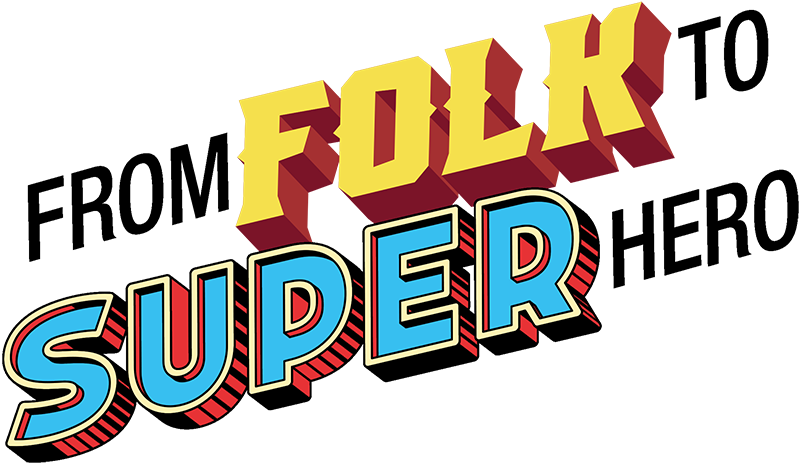
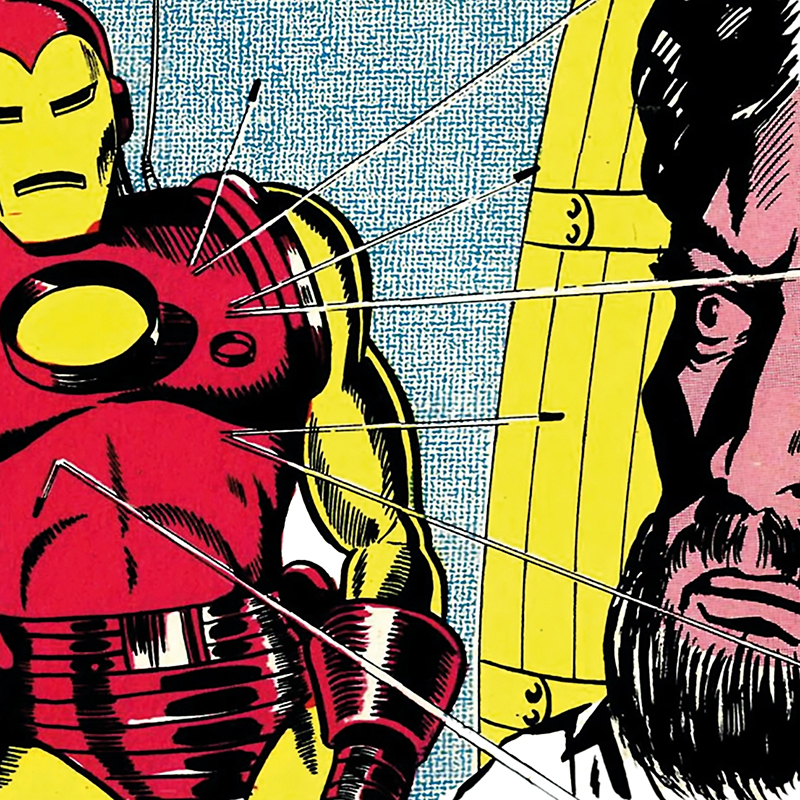
![Kaark the Crow [The Sydney Morning Herald]](https://www.folk2super.com/wp-content/uploads/2020/10/Kaark-the-Crow-06-11-1946-300x200.jpg)
![Stockwhip Sam [The Sydney Morning Herald]](https://www.folk2super.com/wp-content/uploads/2020/10/Stockwhip-Sam-21-05-1947-300x220.jpg)

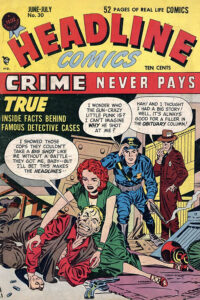
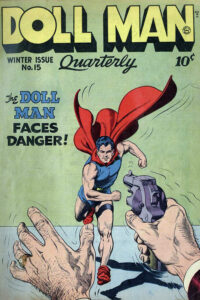

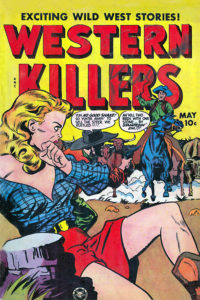


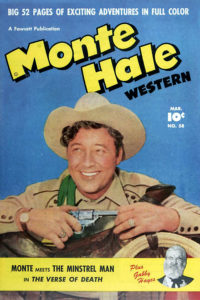

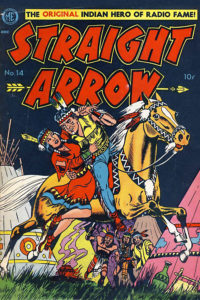
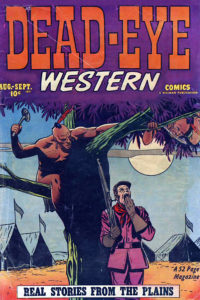

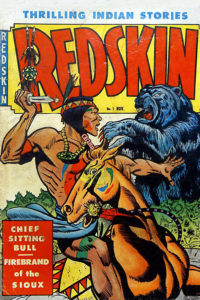


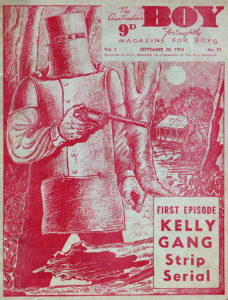
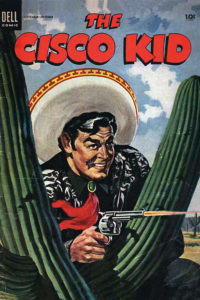
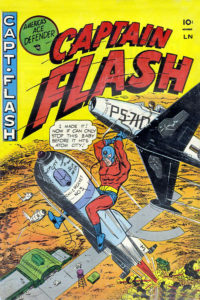
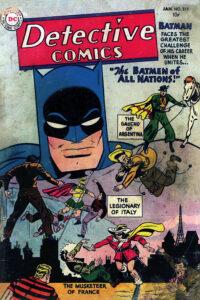
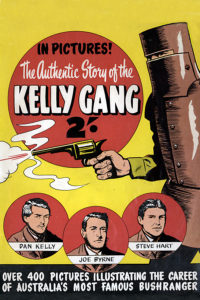
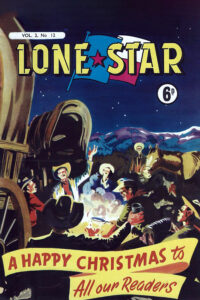

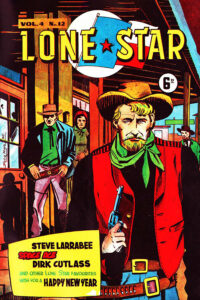

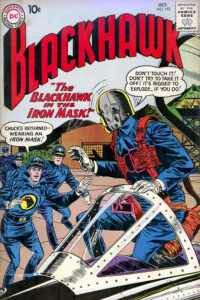
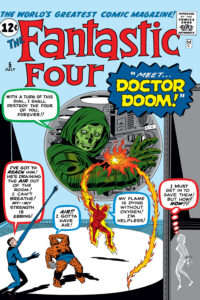


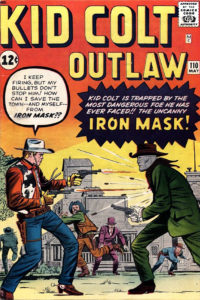


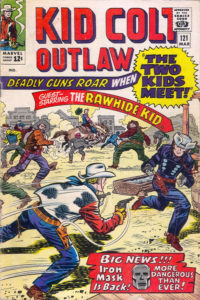
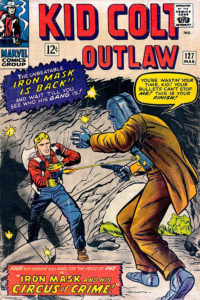
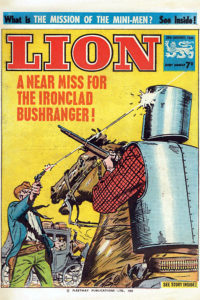

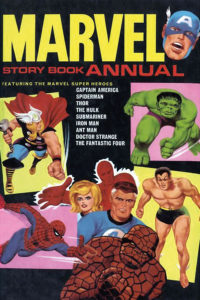


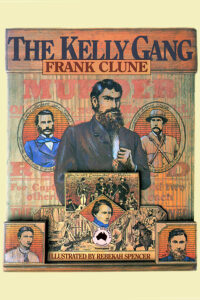
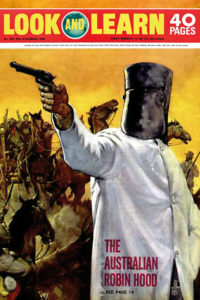
 Issue: #522
Issue: #522